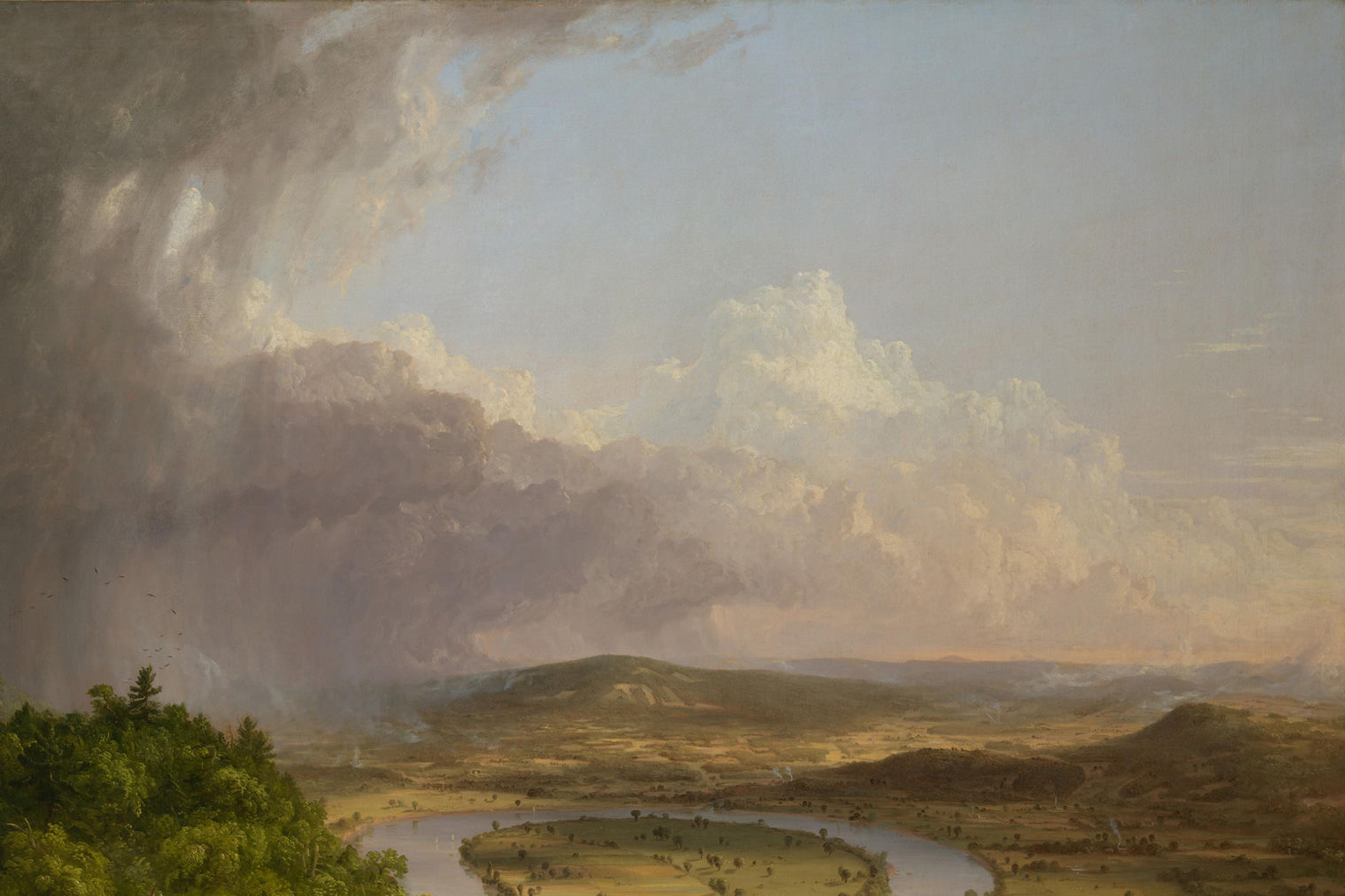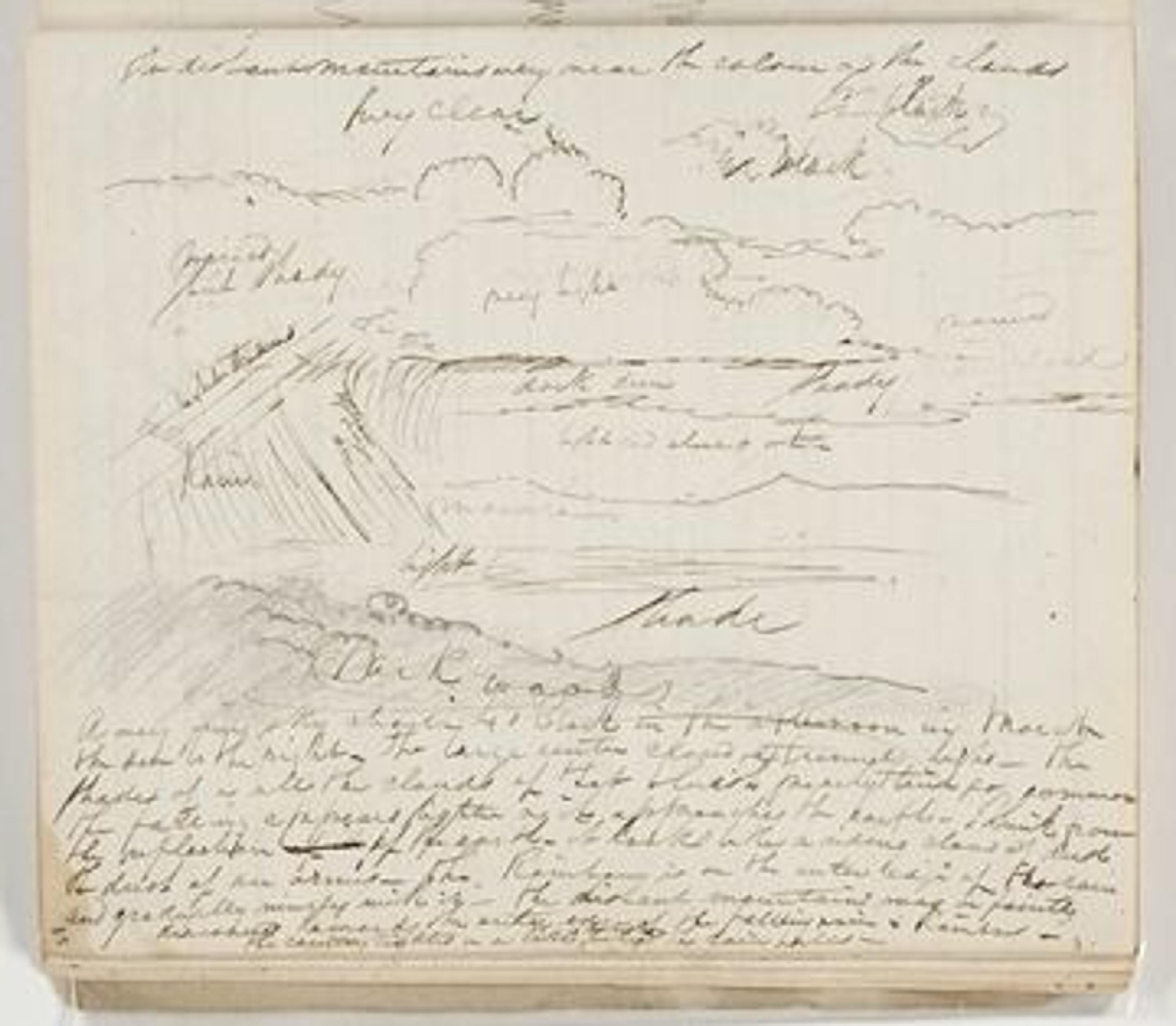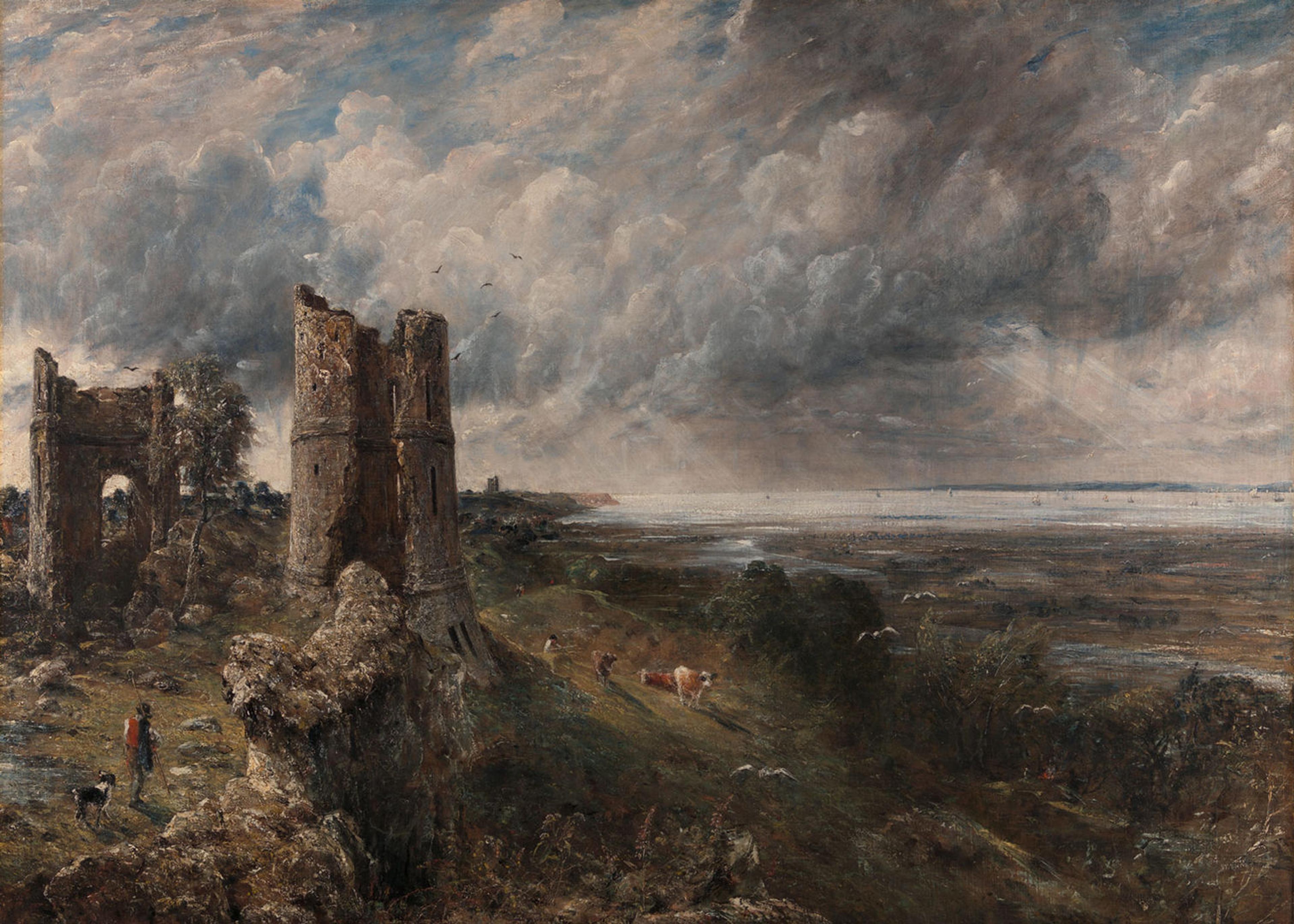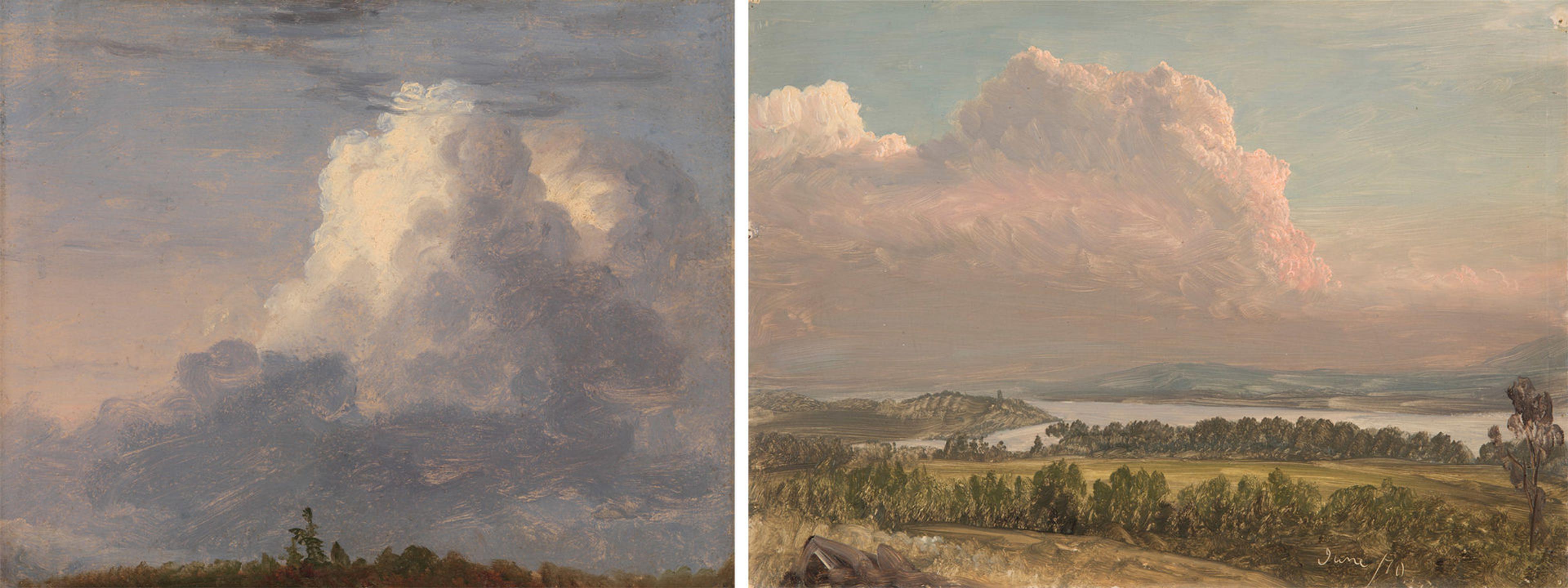"The soul of all scenery": Thomas Cole's Clouds

Thomas Cole (American, 1801–1848). View from Mount Holyoke, Northampton, Massachusetts, after a Thunderstorm—The Oxbow (detail), 1836. Oil on canvas, 51 1/2 x 76 in. (130.8 x 193 cm). The Metropolitan Museum of Art, New York, Gift of Mrs. Russell Sage, 1908 (08.228)
Thomas Cole—the subject of a recently closed exhibition at The Met, traveling soon to The National Gallery, London—studied, sketched, and painted clouds throughout his career. As early as 1825, he copied in his notebook the formula for painting skies found in William Oram's Precepts and Observations on the Art of Colouring in Landscape Painting (1810), and his notebooks are filled with written empirical observations as well as graphite on-site studies of clouds, such as Atmospheric Study with Notations, which he inscribed, "Thunderstorm after Sunset."

Left: Thomas Cole (American, 1801–1848). Atmospheric Study with Notations, ca. 1825. Pen and brown ink over graphite pencil on off-white wove paper, sheet: 6 1/2 x 7 5/8 in. (16.5 x 19.4 cm). Detroit Institute of Arts, Founders Society Purchase, William H. Murphy Fund (39.681.24)
While in London from 1829 to 1831, Cole was exposed to the grand-scale canvases that included dramatic cloud effects as well as the on-site, or plein-air, cloud studies of Joseph Mallord William Turner and John Constable. On a visit to the Royal Academy on June 29, 1829, for example, Cole saw Constable's Hadleigh Castle, The Mouth of the Thames—Morning after a Stormy Night, which he greatly admired and which features a dramatic cloud-filled sky.

John Constable (British, 1776–1837). Hadleigh Castle, The Mouth of the Thames—Morning after a Stormy Night, 1829. Oil on canvas, 48 x 64 3/4 in. (121.9 x 164.5 cm). Yale Center for British Art, New Haven, Paul Mellon Collection (B1977.14.42)
Cole met Constable later that year and had the opportunity to view Constable's oil studies. Constable had studied meteorological treatises and, working directly from nature, produced a series of now-celebrated cloud studies in the 1820s, including such examples asRainstorm over the Sea and Study of a Cloudy Sky.

Left: John Constable (British, 1776–1837). Rainstorm over the Sea, ca. 1824–28. Oil on paper laid on canvas, 9 1/4 x 12 7/8 in. (23.5 x 32.6 cm). Royal Academy of Arts, London, Given by Isabel Constable, 1888 (03/1390). Right: John Constable (British, 1776–1837). Study of a Cloudy Sky, ca. 1825. Oil on paper on millboard, 10 3/8 x 13 in. (26.4 x 33 cm). Yale Center for British Art, New Haven, Paul Mellon Collection (B1981.25.124)
In a famous letter penned October 1821, Constable wrote:
I have done a great deal of skying. . . . That landscape painter who does not make his sky a very material part of his composition, neglects to avail himself of one of his greatest aids. . . . It will be difficult to name a class of landscape in which the sky is not the key-note, the standard of scale, and the chief organ of sentiment.
Cole, in his famous "Essay on American Scenery" of 1836, echoed Constable's sentiment, writing that the sky is "the soul of all scenery, in it are the fountains of light, and shade, and color," and declaring that "for variety and magnificence, American skies are unsurpassed."
As a keen observer of weather conditions, Cole used the sky in such major works as The Met's View from Mount Holyoke, Northampton, Massachusetts, after a Thunderstorm—The Oxbow to convey the central narrative and "soul" of the painting. His storm-filled sky, or swirling vortex of clouds, was directly inspired by Turner's Snow Storm: Hannibal and His Army Crossing the Alps, which he had greatly admired while visiting the artist's London studio in 1831.

Joseph Mallord William Turner (British, 1775–1851). Snow Storm: Hannibal and His Army Crossing the Alps, exhibited 1812. Oil on canvas, 57 1/2 x 93 1/2 in. (146 x 237.5 cm). Tate Britain, London, Accepted by the nation as part of the Turner Bequest 1856 (N00490)
Cole eventually mastered the pure cloud study, including the fine example Clouds from The Met collection. Here, the palpable brushstrokes suggest the immediacy of the artist's perceptions. His handling of color is subtle: the lower section of the towering cloud formation is gray, gray-purple, and gray-white, while the upper portion tends toward pure bright white. Inspired by Constable's cloud studies, Cole included a line of treetops at the lower edge of the composition to establish a sense of scale.

Left: Thomas Cole (American, 1801–1848). Clouds, ca. 1830s. Oil on paper laid down on canvas, 8 3/4 x 10 7/8 in. (22.2 x 27.6 cm). The Metropolitan Museum of Art, New York, Morris K. Jesup Fund, 2013 (2013.201). Right: Frederic Edwin Church (American, 1826–1900). Sunset across the Hudson Valley, 1870. Oil and graphite on paperboard, 11 1/8 x 15 1/4 in. (28.3 x 38.7 cm). Copper-Hewitt, Smithsonian Design Museum, New York, Gift of Louis P. Church (1917-4-582-a)
This study, and others by Cole, may well have been seen by young Frederic Edwin Church during his two-year instruction with Cole, in his Catskill studio from 1844 to 1846, when Cole directly taught Church the art of plein-air painting. Church would go on to paint his own scientifically observed cloud studies, including Sunset across the Hudson Valley, a work that looks southwest across the Hudson River toward Cedar Grove, Cole's home and studio where Church first learned the art of painting clouds.
Related Content
Thomas Cole's Journey: Atlantic Crossings was on view at The Met Fifth Avenue January 30–May 13, 2018.
Read a blog series about Thomas Cole on Now at The Met.
See more digital content related to Thomas Cole, including a walkthrough of the recent exhibition.
The exhibition catalogue is available for purchase in The Met Store.
Elizabeth Kornhauser
Elizabeth Mankin Kornhauser is the Alice Pratt Brown Curator of American Paintings and Sculpture in The American Wing.